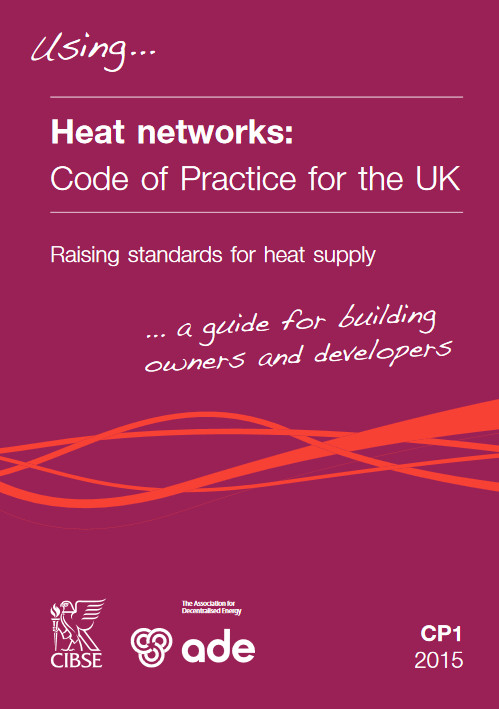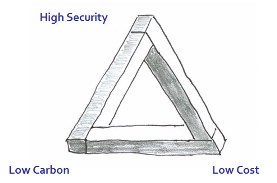Articles
Heat Networks
Why use Heat Networks?
- Power stations generate electricity and heat – the heat is generally wasted to atmosphere in "cooling towers".
- It would be good if the waste heat could be piped to buildings to provide heating.
- DECC has for many years been hoping to see an increase in the 2% of buildings in the UK served by district heating.
- CIBSE has responded by publishing a Code of Practice to encourage the efficient use of district heating.
- The Code highlights the issues to be considered and – inadvertently – explains why the uptake has been so low.
CP1 Heat Networks
The Heat Networks Code of Practice has been produced by CIBSE and ADE with extensive participation from AECOM, Cofely, DECC, GLA and many others. The introduction to the Code states that:
The development of heat networks (or district heating) in the UK is increasingly recognised as an important component in the UK's future energy strategy (DECC, 2013).
Heat networks can address the 'energy trilemma' by meeting the following strategic aims:
- To reduce greenhouse gas emissions through the use of a wide range of low carbon and renewable heat sources.
- To improve security of energy supply by diversifying the energy sources for heating and reducing our dependence on fossil fuel imports.
- To offer a supply of heat that is good value and that contributes to reducing fuel poverty.
Why are gas-based Combined Heat and Power Networks not being adopted?
There are a number of barriers to the uptake of gas-based Combined Heat and Power Networks. The reasons can be categorised under the headings of Cost, Legal, Environmental and Customer resistance:
Cost
There are some important reasons why it is expensive to install a CHP-based district heat network:
- Space needs to be found to accommodate a CHP engine
- a high temperature heat network requires large diameter steel piping to distribute hot water
- heat losses to the ground will be suffered unless expensive insulation is used
- the heat loads need to be carefully established in advance – because subsequent increases are expensive, and reduced loads limit efficiency
- major capital costs have to be financed before income can be collected
- major running costs require ongoing metering and administration costs.
Legal
It is not easy to get all parties to commit to the binding long term contracts to take heat that are needed before finance can be agreed and construction can begin.
Environmental
Air quality is an increasing concern, especially in city centres, and all CHP engines rely on combustion which emits NOx and SOx as well as CO2.
Customer resistance
Consumers have traditionally been resistant to signing long term contracts, with a concern that they may have to share costs of heating provided to others.
CHP based heat networks do not provide any cooling.
What is the alternative to using CHP?
There is an attractive alternative to gas-based CHP district heating which is more effective in resolving each of the three facets of the Energy Trilemma. To avoid emitting CO2 from heating it is important to avoid combustion. This can be done with the electrification of heating and utilising:
- heat collection in summer,
- heat storage over the autumn
- and heat transfer in winter.
These can all be achieved using ground source heat pumps which can also concentrate heat.
The alternative to using CHP is a Heat Sharing Network
Instead of an expensive central energy centre sending hot water through an expensive steel pipe network, a small diameter flexible plastic pipe network connects each building with water close to ground temperature. Each building employs a heat pump to extract heat if it needs heating, or reject heat if it needs cooling.
This radically simpler mechanism yields no carbon emissions on site – nor any other product of combustion – and allows for incremental expansion of the network at marginal cost. Each building is in control of its own costs and its own temperature controls.
| Traditional Gas-Powered District Heating | Heat Sharing Networks |
| High cost of insulated steel pipework | Low temperature flexible plastic pipe network |
| No cooling without separate additional circuit | Cooling from heat pumps |
| Large additional cost for cold circuit | Separate cold circuit not required |
| High cost of central heat generation | Low cost local heat pumps borne by tenants |
| High running costs of central heat generation | Local heat pumps under tenants' control |
| Admin cost of metering, accounting, collecting revenues | Tenants pay their own electric cost directly |
| Heat Sharing dividend | |
| CHP systems emit CO2 and other noxious gases | No on-site emissions at all |
| Can use waste heat | |
| No heat recycling | Provides Seasonal Thermal Energy Storage |
| Uncertainty of future heat demand | Allows incremental expansion |
| Uncertainty of future heat sources | |
| Legal cost of agreements to share capital costs | Legal cost of agreements to share (lower) capital costs |
| Legal cost of agreements to share high running costs | Low central running cost minimises risk |
| Legals need to meet changes of tenants during the scheme | Fewer barriers to new tenants - low risk to existing tenants |



